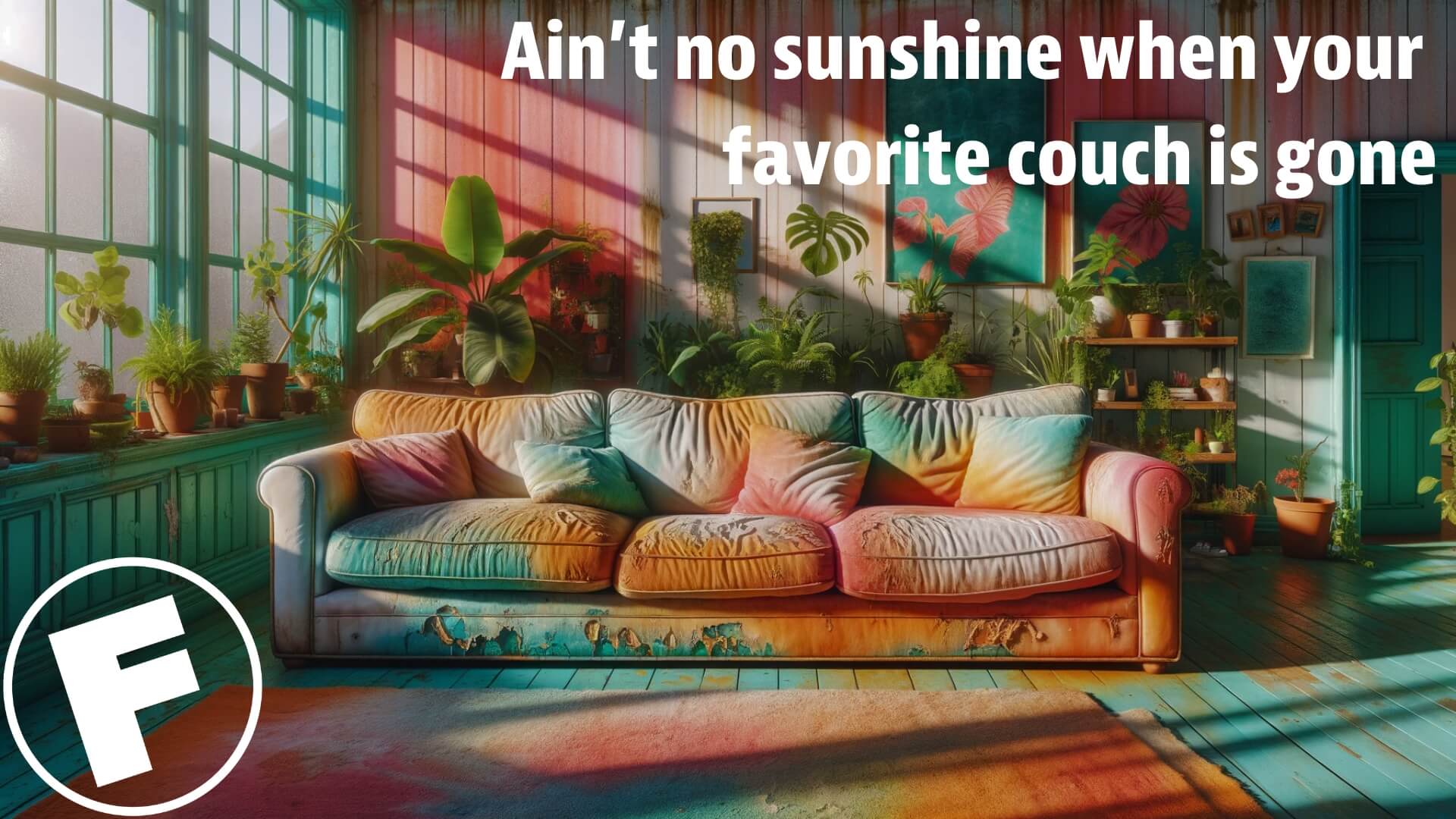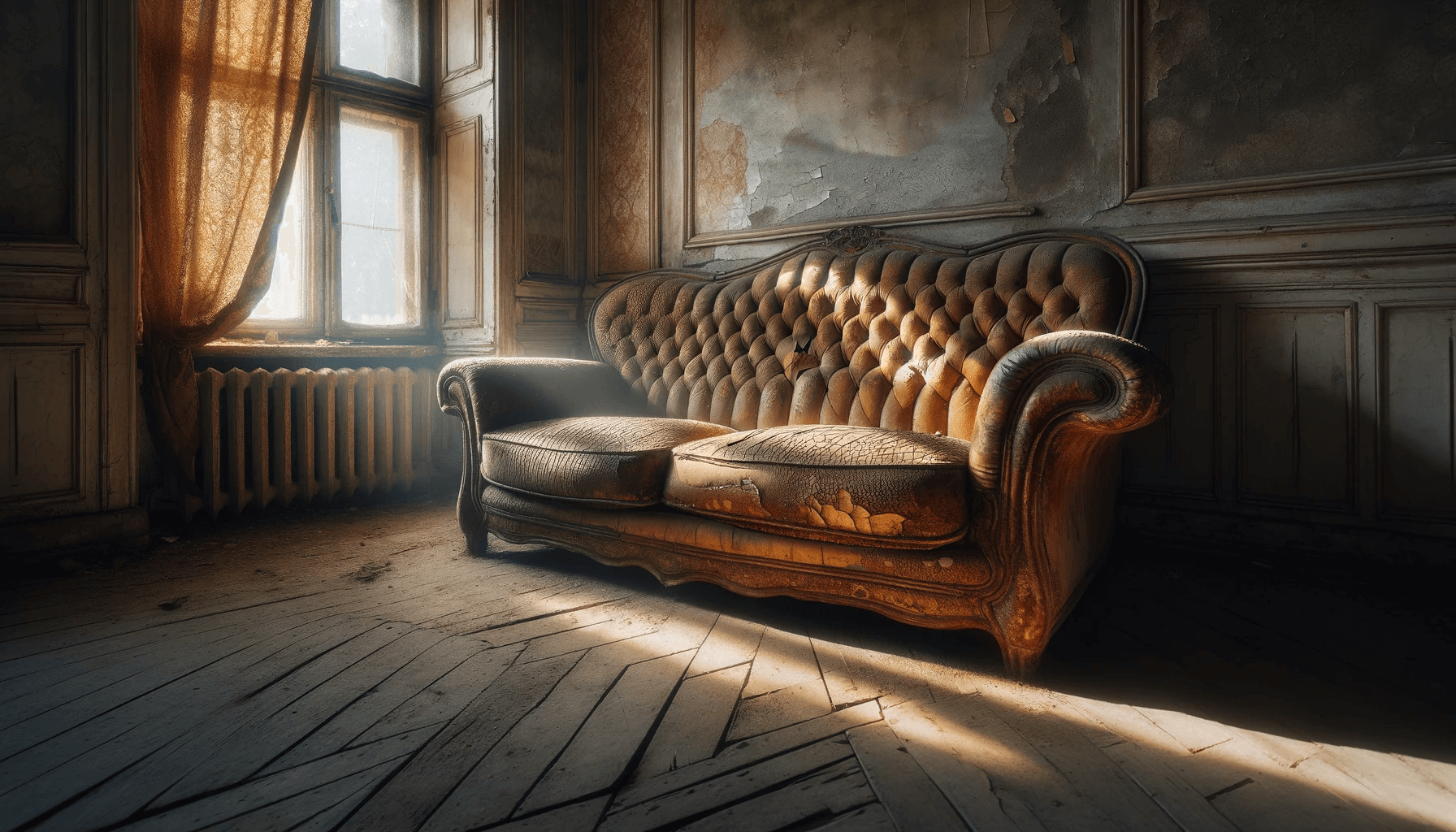How to Prevent Sun Damage to Leather
Unfortunately, sun and leather don’t usually mix well. Too much sunlight will do one of two things (and possibly both) to leather furniture and other upholstery– fading and drying.
Let’s take a quick look at how to counteract such a woeful occurrence!

Fading is commonly seen in semi-aniline and aniline leathers, but is a little rarer in fully-finished leathers that have a protective top coat. It’s one of the most common problems we see, and if you put different types of leather furniture next to a window that gets some serious sunlight, you can start to see fading in as little as 4 to 6 months.
Drying, on the other hand, is something the sun will do to almost any kind of leather – fully-finished or not. The heat of sunlight causes the moisture in the leather’s natural oils to slowly evaporate, and eventually, it will dry, stiffen, and crack.
These are both common problems—and no—you don’t have to live with the shades drawn 24/7. There are a few highly effective ways to fight both types of sun damage—it just takes a little preventative maintenance.
How do I prevent sun damage to my leather?
The best way to prevent drying in fully finished, semi-aniline, and aniline leathers (except Nubuck) is by cleaning and protecting them 3 to 4 times a year. Here is a quick tutorial on cleaning and protecting leather.
Cleaning and protecting is key, but another good idea is to try your best to keep leather furniture out of direct sunlight. Regardless of how much cleaning and protecting you do, if you put a leather sofa directly in front of a sunny window, you’re asking for trouble. It is helpful to close the blinds during the sunniest, hottest parts of the day.
Here are some simple practical steps you can take at any time:
- Shade and Cover: Keep leather items out of direct sunlight when possible, and use curtains, blinds, or UV-protective films to shield them from sunlight indoors.
- Store Properly: Store leather items in a cool, dry place away from direct sunlight. Use dust covers or garment bags for added protection.
- Condition Regularly: Apply a leather conditioner every few months to keep the leather hydrated and resistant to damage.
- Use UV-Protective Products: Consider using leather products with built-in UV protection, such as sprays or creams.
Remember that dark colors absorb more light, and therefore more heat, from the sun. Leather is no exception, so try to avoid putting dark-colored leather in direct sunlight if you can.
Prevent Fading
As we said, fading is mainly a problem that affects analine and semi-analine leathers. The only true way to prevent the fading of leather from sunlight is to keep it out of the sun.
Try to place semi-aniline and aniline leather furniture out of direct sunlight whenever possible, and follow the closed blinds tip above if you do have to place these leathers in a sunny spot. If you need to put a piece of leather furniture in direct sunlight, as most people do, we recommend fully-finished leather because of its durability and resistance to fading – so think about where you’re going to put your furniture before you buy if at all possible.

Your leather furniture doesn’t need to look like it belongs to Dracula
What about car seats?
Since the leather in your car is likely to be exposed to a lot of sunlight and heat, car manufacturers use leather that is highly resistant to sun damage in their interiors.
It usually holds up a lot longer in the sun than most furniture leather, but it’s still a good idea to clean and protect it a couple of times a year. You can also try using window shields or a sheer curtain to keep some of the light and heat off your leather if you park in the sun for extended periods of time.
What if my leather is already sun-damaged?
Here are some of your options if you’re faced with leather that has already been negatively affected by sunlight.
Faded leather
Once leather has faded, the only way to get the color back is to re-dye and color-match it, which you’ll need a professional to do.
The cost varies depending on the size of the affected area and the extent of the problem. The best way to get an idea of cost is to ask a local professional who can do the work for you. Most pros who know what they are doing will give you an estimate for free—we do at Fibrenew.
Dried leather
People always ask us, “Can you rehydrate leather once it has been dried out?”
The simple answer is no; once the natural oils found in leather are gone, they’re gone for good. This is why cleaning, protecting, and preventative maintenance are so important. While it would be incredibly time-consuming and impractical for a professional to attempt to rehydrate dried-out leather, your best bet is going to be to patch it, redye it and you won’t notice the difference when it’s done.
A word of warning
We have seen lots of advice on the internet suggesting that people treat their leather with olive oil to prevent drying. Let me be clear, this is NOT a good idea.
Leather is extremely porous by nature, so it will soak up any oils you put on it – and that includes popcorn grease, conditioning oils, body oils, and olive oil. The oil gets soaked into the back side of the leather – the part you can’t see.
Then eventually it ends up saturating broader areas as it naturally fills up from back to front over time. Once oil saturates the leather, you end up with oil spots on the surface and a problem that is much harder to solve than dried-out leather, like in this photo.
Fibrenew is here to help with all your leather needs
Get in touch with us today with any questions you might have.
And remember, contact your local Fibrenew operator for help with all of your leather, vinyl, and plastic restoration needs!
What is sun damage to leather? Sun damage to leather refers to the deterioration and discoloration of leather caused by prolonged exposure to sunlight and UV rays. It can result in fading, drying, cracking, and a loss of the leather’s natural qualities. What leather items are vulnerable to sun damage? Almost any leather item exposed to sunlight can be susceptible to sun damage. Common examples include leather furniture, car interiors, jackets, handbags, shoes, and leather accessories. How does the sun cause damage to leather? Sun damage occurs due to the ultraviolet (UV) radiation in sunlight. UV rays can break down the collagen fibers in leather, leading to the loss of flexibility and strength. They can also fade the dye used to color the leather. How can I prevent sun damage to my leather items? To prevent sun damage to leather, follow these steps: Can I use natural oils like coconut oil to protect leather from the sun? While natural oils like coconut oil can provide some hydration to leather, they may not offer sufficient UV protection. It’s best to use dedicated leather conditioners and UV-protective products for more effective prevention. What should I do if my leather item is already sun-damaged? If your leather has already suffered sun damage, follow these steps: Can I use sunscreen on leather for protection? It’s not recommended to use sunscreen meant for skin on leather items. Sunscreen may contain chemicals and oils that can harm leather. Use dedicated leather protection products instead. How can I tell if my leather item has sun damage? Signs of sun damage in leather may include faded or uneven color, dryness, stiffness, cracks, and a lack of luster. If you notice these symptoms, it’s likely that your leather item has been sun-damaged. Are there professional leather care services for sun-damaged leather? Yes! Fibrenew professionals are confident and capable of taking care of anything you need leather-wise.Sun Damage to Leather FAQ

